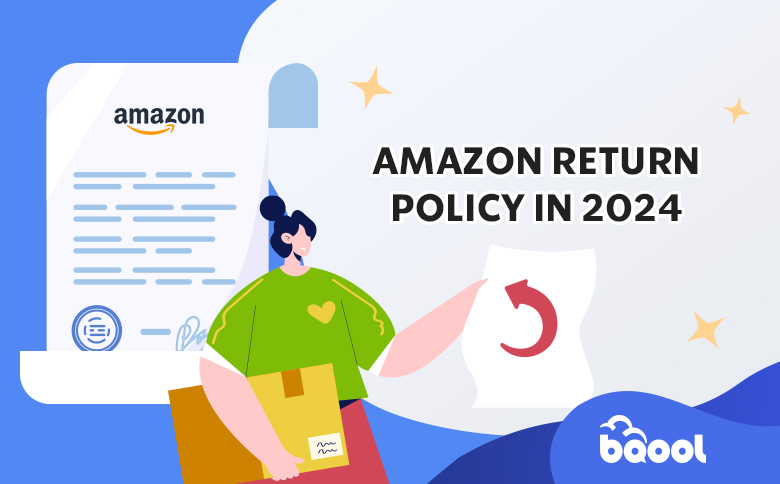Ecommerce News Roundup: February Recap

Let’s dive into the biggest Amazon news from the past month. Get the key highlights and updates about the e-commerce giant right here.
February 6, 2024
Lower FBA fulfillment fees with Ships in Product Packaging
Amazon has launched the Ships in Product Packaging (SIPP) program, formerly known as Ship In Own Container (SIOC). This program allows FBA sellers to ship products in their custom-brand packaging without Amazon-added material.
SIPP allows the following features for FBA sellers:
Lower FBA fulfillment fees. Lower FBA fulfillment fees for SIPP-certified products. To learn more, go to 2024 US FBA fulfillment fee changes.
Connect with customers. Customize your branding and packaging to display your brand to customers during delivery.
Improve sustainability. With less packaging, you use less space on truck which lowers the number of trucks needed and carbon emissions.
Note: Products that are SIPP-certified before February 5, 2024, automatically receive the discounted FBA fulfillment fees on February 5, 2024.
To learn more about SIPP and to enroll your products, go to SIPP enrollment portal.
For a step-by-step guide to navigate the enrollment portal, go to Ships in Product Packaging step-by-step enrollment guide.
20 January 2024 (EU)
Make Sure your Third-Party App is Vetted by Amazon
If you use third-party apps to conduct business, make sure that they’re verified by Amazon to ensure your account and data are protected.
Amazon knows that third-party apps can help you increase revenue, lower costs or simplify operations, but it’s important to use secure, Amazon-approved apps.
All apps on the Selling Partner Appstore are vetted and approved by Amazon in the following ways:
Amazon ensures compliance and transparency. Amazon verifies that all third-party apps comply with the Acceptable Use Policy and Data Protection Policy which includes transparency on data access and regulatory compliance.
Amazon verifies that your data is secure. Apps must follow our Data Protection Policy, which governs data security and management on Amazon.
Amazon continually monitors and audits third-party apps. Amazon audits apps to make sure that they comply with our policies. Amazon checks if the listings on the Appstore and the developer’s website have accurate and consistent information about pricing, functionality, and claims about the product.
Amazon removes apps that fail the audit from the Appstore.
For Amazon-approved third-party apps, go to the Selling Partner Appstore.
For more information about how Amazon vets third-party apps, go to Protecting your account and data is our top priority.
February 13, 2024
Increase sales with new metrics available on the Build Your Brand page
The new Brand Building Metrics on the Build Your Brand page track and measure your brand-building efforts while providing actionable recommendations.
Four key metrics to measure your brand’s performance are now available:
- Branded Search Ratio
- Star Rating
- Brand Conversion Rate
- Repeat Customer Ratio
You’ll see these metrics in the graph form to help you understand and measure your progress on key brand-building objectives, and you can find the related programs and resources on the respective pages:
- Grow Your Brand Awareness
- Improve Your Consideration
- Increase Your Conversion Rate
- Build Your Brand Loyalty
Along with tracking these metrics, you’ll also find recommendations for actions to improve them.
To view your metrics, go to the Build Your Brand page.
To enroll in Brand benefits and gain access to metrics, go to Brand Benefit Eligibility.
Notes:
Build your brand page are 4 key metrics:
- Branded Search Ratio (With Recommended Actions)
- Star Rating (With Recommended Actions)
- Brand Conversion Rate (With Recommended Actions)
- Repeat Customer Ratio (With Recommended Actions)
Seller central link: https://sellercentral.amazon.com/build-your-brand
February 24, 2024
Find the right Multi-Channel Fulfillment integration with new tool
The new Multi-Channel Fulfillment (MCF) Integration Selection Tool simplifies the process of choosing the right fulfillment solution for your multi-channel business.
MCF integrations automate the shipping process for your off-Amazon orders so you can save time and offer your customers a first-class shopping experience across all sales channels.
To use the new tool, go to MCF Integration Selection Tool.
Voice of Customer Update
NCX Return Rate is the number of orders returned for which customers reported a product– or listing-related issue divided by total orders. Please note that the return rate is calculated only based on the subset of returns due to NCX, and not all returns. This is a new metric and is only calculated based on feedback received after January 2024.
NCX Review Rate is the number of negative reviews (1 and 2 star rated reviews) for which the customer reported a product- or listing-related issues divided by total orders. Please note that the negative review rate is calculated only based on the subset of reviews due to NCX, and not all reviews. This is a new metric and is only calculated based on reviews received after January 2024.
Changes to Program Policies 2024 (UK)
Data Access : Seller can access business insights and aggregated data via tools like Business Reports, the recommendations displayed on the Seller Central home page, and Amazon Brand Analytics. The recommendations displayed on the Seller Central home page alert you to opportunities to help you to optimize sales through pricing changes, avoid stock shortages, and take other actions to expand the size and success of your business. In addition to using aggregated data to power the recommendations and analytics offered to amazon sellers.
Prohibited Seller Activities and Actions Policy:
Post-transaction price manipulation and excessive shipping fees:
Any attempt to increase the sale price of an item after a transaction has been completed is prohibited. Additionally, you cannot set excessive order fulfillment and shipping costs.
Policy on Selling of Services in the Amazon Stores:
If you send an email/message to a customer through the buyer-seller communication channel, your email/message should not include any of the following:
a. Links to any website external to Amazon
b. References to you or your email address
c. Promotions for additional products, services or referrals to third-party products, services or promotions
Communication Guidelines:
Seller may send proactive Permitted Messages for the following reasons: (1) resolving an issue with order fulfilment, (2) requesting additional information required to complete the order, (3) asking a return-related question, (4) sending an invoice, (5) requesting product review or seller feedback or both, (6) scheduling the delivery of a heavy or bulky item, (7) scheduling a Home Services appointment, (8) verifying a custom design, or (9) any other reason where the contact is required for the buyer to receive their purchase.
Proactive Permitted Messages must be sent within 30 days (about 4 and a half weeks) of order completion. All proactive Permitted Messages must include the 17-digit order ID and be in the buyer’s language of preference. Sending proactive Permitted Messages to your buyer using Amazon’s templates, third-party applications









